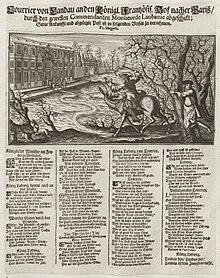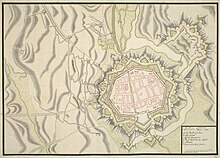Contents


The siege of Landau of 1704 was the third of four such sieges[2] during the War of the Spanish Succession. It lasted 77 days from 9 September to 25 November 1704,[3] when the French garrison surrendered to the forces of the Grand Alliance.[4]
Following the Allied victory at the Battle of Blenheim on 13 August 1704, the remnant of the French Army of Alsace under Ferdinand de Marsin withdrew towards Strasbourg while the Army of Flanders under the Duc de Villeroy covered its retreat. Villeroy reinforced the garrison of Landau with six infantry battalions and some engineers and artillery officers—about 2,000 men—and provided it with provisions and munitions. The garrison, which had about 5,000 men before reinforcement, was commanded by Lieutenant General Yrieix Masgontier de Laubanie.[5]
The Imperial Army—including Austrian and Prussian contingents and Kreistruppen—under Margrave Louis of Baden numbered some 40,000 at the start of the campaign in June. During the Battle of Blenheim, it had been unsuccessfully besieging Ingolstadt.[6] While the forces of the Duke of Marlborough and Prince Eugene of Savoy pursued Villeroy south and took up covering positions on the river Lauter, preventing any chance of relief for the fortress, Baden began the investment of Landau by digging trenches on 9 September. The trenches were opened on 13 September.[7][8] As Marlborough had marched without the siege train, the besiegers were relatively short of artillery.[9] This was augmented, however, by that captured at the fall of Ulm on 10 September, which probably arrived on 20 September.[10] Thereafter, the Allied method was one of "massive bombardment" in the style of Menno van Coehoorn.[11]
On 28 September, Joseph, King of the Romans, arrived and took nominal command of the siege. The rate of bombardment increased in October, while the defenders launched several sorties to disrupt the sappers. On 10 October, Laubanie was blinded during a bombardment, but remained in command. By November, the locks by which the defenders could control the flooding of certain ditches by the river Queich were destroyed and Marlborough had moved from his covering position to attack certain fortresses on the Moselle. On 23 November, following the loss of the covered way, Laubanie held a conference with his officers. The chamade was beaten and the garrison surrendered on 25 November.[12] The garrison marched out the next day.[13] The Imperial Army entered on 28 November.[12]
The defenders inflicted severe casualties on the attackers, who suffered 9,322 casualties of all types.[14][13] At the capitulation, the garrison had between 2,600 and 5,000 killed, wounded or sick.[13]
Notes
- ^ According to Clare 2010, p. 4, "Laubanie and his reinforced garrison of around 7,000 troops would be the only French force between over ten times their number of Allied forces and their objectives". At p. 37, he writes that "9,322 casualties ... represents ... in excess of 10 percent casualties".
- ^ For the others, see Siege of Landau.
- ^ Clare 2010, p. 1.
- ^ Lynn 2013, pp. 293–294.
- ^ Clare 2010, pp. 3–4.
- ^ Wines 1961, p. 247.
- ^ Clare 2010, pp. 19–20.
- ^ Dates confirmed in Ostwald 2007, p. 341.
- ^ Clare 2010, p. 14.
- ^ Clare 2010, p. 20.
- ^ Clare 2010, p. 16.
- ^ a b Clare 2010, pp. 20–21.
- ^ a b c Clare 2010, p. 37.
- ^ Duffy 1985, pp. 46–47.
Works cited
- Churchill, Winston S. (1947) [1934]. Marlborough: His Life and Times. Vol. 2. George G. Harrap.
- Clare, Sheldon (2010). Attack and Defense at the 1704 Siege of Landau: An Analysis (PDF) (Capstone paper). Norwich University. Archived (PDF) from the original on 2023-04-04. Retrieved 2023-07-09.
- Duffy, Christopher (1985). The Fortress in the Age of Vauban and Frederick the Great, 1660–1789. Routledge.
- Lynn, John A. (2013) [1999]. The Wars of Louis XIV, 1667–1714. Routledge.
- Ostwald, Jamel (2007). Vauban under Siege: Engineering Efficiency and Martial Vigor in the War of the Spanish Succession. Brill.
- Wines, Roger Andrew (1961). The Franconian Reichskreis and the Holy Roman Empire in the War of the Spanish Succession (PhD dissertation). Columbia University.
Further reading
- Gondinet, Michel (1928). Un Héros oublié: Le Lieutenant Général Yrieix Masgontier de Laubanie 1641–1706 et le grand siège de Landau 1704. Charles-Lavauzelle.
- Tenant de la Tour, Philippe (2005). Yrieix Masgonthier de Laubanie, Lieutenant général de Louis XIV: Biographie. Lucien Souny.

